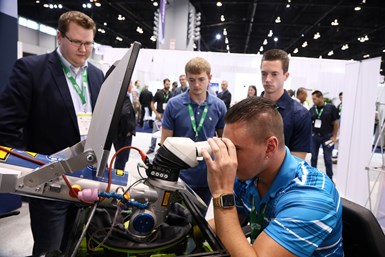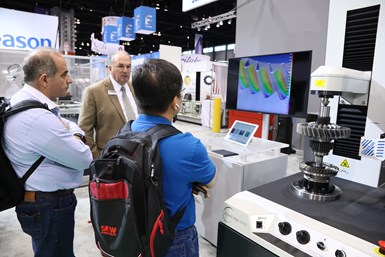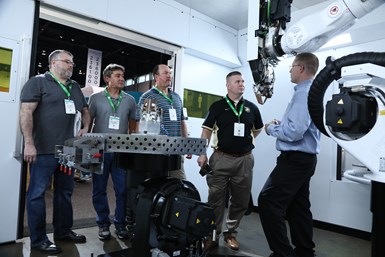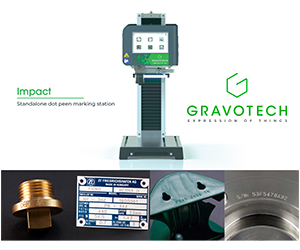Digital Tools Meet Practical Applications
Sponsored ContentDigital manufacturing will see a much larger footprint at IMTS 2022 thanks to technologies that bridge the gap between the digital and physical.
Share
Read Next
Digital manufacturing will see a much larger footprint at IMTS – The International Manufacturing Technology Show, Sept. 12-17, 2022, Chicago, Illinois.
For the past two years, digital technology has proven its value as a key remedy to alleviate workforce shortages and supply chain challenges in the manufacturing world. Many see it as necessary for competing in the global marketplace. According to AMT CTO Tim Shinbara, digital tools are firmly establishing themselves as essential for simplifying and improving manufacturing businesses.
Job shops attending IMTS will have the opportunity to get hands-on experience with new technologies that can improve their operations.
“Every investment that a shop makes is a business decision, which means that every investment has to pay for itself,” Shinbara says. “What data-driven manufacturing does is provide the infrastructure to improve how a business runs.” Essentially, these digital tools are designed to provide resources for making informed decisions on how to run a shop. But what factors should a job shop weigh when deciding which technologies to invest in?
Cutting Tool Management
IMTS is the largest manufacturing show in North America, which means that job shop owners who attend the show will have access to hundreds of companies for one-on-one networking and learning opportunities.
Cutting tool management is a vital part of the daily functioning of every machine shop, as no chips are flying without the right tools in stock. Some shops have turned to digital tools that help them keep accurate digital records of their cutting tool needs, shifting the workload of maintaining tool inventories from managers to digital tools.
Some digital solutions create digital twins of their cutting tools, enabling the shop to keep track of wear over time. In addition to tool wear, software can keep track of stock and even the location of cutting tools to improve the users’ ability to prepare for upcoming jobs. Essentially, the software does the work of keeping track of the tools so that the user can make informed decisions.
Additionally, job shops can find use in digital tools that assist in cutting tool setup. For example, digital boring heads from some companies enable users to eliminate lengthy setups by automatically generating cutting parameters. The user enters the workpiece material and bore diameter, and the app automatically generates feed rates, inserts and insert holders, dramatically reducing the time it takes to prepare a job.
Job shops might find tool management especially helpful, as the variety of jobs coming through high-mix, low-volume shops makes tool management more complicated. Having the right tools available for an upcoming job is vital to staying profitable. Smaller shops, where people often have to fill multiple roles, are just as likely to find use with these systems as larger facilities.
Machine Monitoring and Facility Management
Monitoring machine uptime is becoming more and more common, and manufacturers are finding more ways to exploit this data as the practice evolves over time. Keeping track of this data can help shops make informed decisions to address issues with production. If, for example, a machine is showing frequent downtime because of part changes, the facility manager has exactly the information needed to justify investing in automated solutions for changing out parts.
Attendees at IMTS have the opportunity to learn about and interact with digital tools that can improve their shops. These digital tools make running a shop with limited employees much easier and more profitable.
More importantly, machine monitoring systems can provide a facility with the tools needed to enhance the contributions of the people working there. These systems can identify bottlenecks that slow down jobs, helping the manufacturing team to gain a clearer picture of what processes need their attention. If the data shows that one process is slowing production, it provides a focal point for developing improvements that can drastically cut down the time a part spends in the shop.
Machine monitoring is not a solution in and of itself. Rather, it is a guide that can illuminate problems in a process, enabling the user to fix those problems on their own. One shop, for example, might realize that its new five-axis mill is experiencing a lot of down time when switching between parts. This shop might invest in a pallet-changing system to keep the machine running while setting up new jobs. However, solving that problem is impossible until you manage to identify it.
Preventative maintenance
At IMTS, visitors will have unique opportunities to speak with vendors and OEMs to learn about tools and techniques that will improve their shops.
Another emerging area in which data-driven manufacturing is proving its value is in preventative maintenance. Few things are more expensive than repairing a large machine, as the loss in productivity magnifies the drain the busted equipment has on the shop. Fortunately, newer digital tools can avoid unplanned repairs by scheduling preventative measures that are less expensive and more effective than making repairs after a breakdown occurs.
This technology is an outgrowth of standard machine monitoring. However, it takes advanced software to analyze the fail states of machines, identify patterns in machine data that precipitates these breakdowns, and identify maintenance needs before anything goes wrong. While it often takes months for software to recognize the problems that can shut down a machine, once a preventative maintenance system familiarizes itself with your machines it can drastically reduce the number of breakdowns you experience, paying for itself many times over.
Scratching the Surface
These applications barely touch the myriad possibilities that digital tools are offering job shops today. Digital shop management tools can perform varied tasks from improving the process of scheduling and planning jobs to keeping management up to date from across the country. As Shinbara says, “These tools create super users without adding extra buttons to the machine.”
For a deeper dive into the topic of digital tools, watch the Tech Trends Podcast below. The hosts discuss this article as well as a few examples of how to use data to improve day-to-day operations.
IMTS 2022 will take place September 12-17 at McCormick Place in Chicago, Illinois. Check out IMTS.com to learn more and register today.























.png)





.png)
